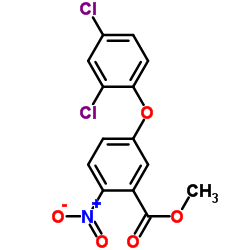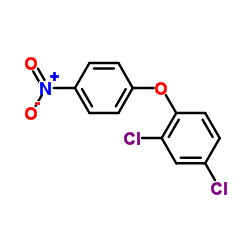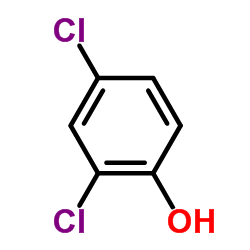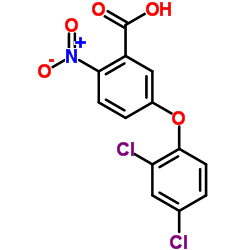Bifenox

Bifenox structure
|
Common Name | Bifenox | ||
|---|---|---|---|---|
| CAS Number | 42576-02-3 | Molecular Weight | 342.131 | |
| Density | 1.5±0.1 g/cm3 | Boiling Point | 421.0±45.0 °C at 760 mmHg | |
| Molecular Formula | C14H9Cl2NO5 | Melting Point | 83 - 85ºC | |
| MSDS | Chinese USA | Flash Point | 208.4±28.7 °C | |
| Symbol |

GHS09 |
Signal Word | Warning | |
| Name | bifenox |
|---|---|
| Synonym | More Synonyms |
| Density | 1.5±0.1 g/cm3 |
|---|---|
| Boiling Point | 421.0±45.0 °C at 760 mmHg |
| Melting Point | 83 - 85ºC |
| Molecular Formula | C14H9Cl2NO5 |
| Molecular Weight | 342.131 |
| Flash Point | 208.4±28.7 °C |
| Exact Mass | 340.985779 |
| PSA | 81.35000 |
| LogP | 4.52 |
| Vapour Pressure | 0.0±1.0 mmHg at 25°C |
| Index of Refraction | 1.608 |
| InChIKey | SUSRORUBZHMPCO-UHFFFAOYSA-N |
| SMILES | COC(=O)c1cc(Oc2ccc(Cl)cc2Cl)ccc1[N+](=O)[O-] |
|
Section1. IDENTIFICATION OF THE SUBSTANCE/MIXTURE Product identifiers Product name: Bifenox CAS-No.: 42576-02-3 Relevant identified uses of the substance or mixture and uses advised against Identified uses: Laboratory chemicals, Manufacture of substances Section2. HAZARDS IDENTIFICATION Classification of the substance or mixture Classification according to Regulation (EC) No 1272/2008 [EU-GHS/CLP] Acute aquatic toxicity (Category 1) Chronic aquatic toxicity (Category 1) Not a hazardous substance or mixture according to EC-directives 67/548/EEC or 1999/45/EC. Label elements Labelling according Regulation (EC) No 1272/2008 [CLP] Pictogram Signal wordWarning Hazard statement(s) H410Very toxic to aquatic life with long lasting effects. Precautionary statement(s) P273Avoid release to the environment. P501Dispose of contents/ container to an approved waste disposal plant. Supplemental Hazardnone Statements Other hazards - none Section3. COMPOSITION/INFORMATION ON INGREDIENTS Substances Synonyms: Methyl 5-(2,4-dichlorophenoxy)-2-nitrobenzoate Formula: C14H9Cl2NO5 Molecular Weight: 342,13 g/mol Section4. FIRST AID MEASURES Description of first aid measures General advice Consult a physician. Show this safety data sheet to the doctor in attendance. If inhaled If breathed in, move person into fresh air. If not breathing, give artificial respiration. Consult a physician. In case of skin contact Wash off with soap and plenty of water. Consult a physician. In case of eye contact Flush eyes with water as a precaution. If swallowed Never give anything by mouth to an unconscious person. Rinse mouth with water. Consult a physician. Most important symptoms and effects, both acute and delayed Indication of any immediate medical attention and special treatment needed no data available Section5. FIREFIGHTING MEASURES Extinguishing media Suitable extinguishing media Use water spray, alcohol-resistant foam, dry chemical or carbon dioxide. Special hazards arising from the substance or mixture Carbon oxides, nitrogen oxides (NOx), Hydrogen chloride gas Advice for firefighters Wear self contained breathing apparatus for fire fighting if necessary. Further information no data available Section6. ACCIDENTAL RELEASE MEASURES Personal precautions, protective equipment and emergency procedures Avoid dust formation. Avoid breathing vapors, mist or gas. Ensure adequate ventilation. Evacuate personnel to safe areas. Environmental precautions Prevent further leakage or spillage if safe to do so. Do not let product enter drains. Discharge into the environment must be avoided. Methods and materials for containment and cleaning up Pick up and arrange disposal without creating dust. Sweep up and shovel. Keep in suitable, closed containers for disposal. Reference to other sections For disposal see section 13. Section7. HANDLING AND STORAGE Precautions for safe handling Provide appropriate exhaust ventilation at places where dust is formed.Normal measures for preventive fire protection. Conditions for safe storage, including any incompatibilities Store in cool place. Keep container tightly closed in a dry and well-ventilated place. Specific end use(s) no data available Section8. EXPOSURE CONTROLS/PERSONAL PROTECTION Control parameters Components with workplace control parameters Exposure controls Appropriate engineering controls Handle in accordance with good industrial hygiene and safety practice. Wash hands before breaks and at the end of workday. Personal protective equipment Eye/face protection Use equipment for eye protection tested and approved under appropriate government standards such as NIOSH (US) or EN 166(EU). Skin protection Handle with gloves. Gloves must be inspected prior to use. Use proper glove removal technique (without touching glove's outer surface) to avoid skin contact with this product. Dispose of contaminated gloves after use in accordance with applicable laws and good laboratory practices. Wash and dry hands. The selected protective gloves have to satisfy the specifications of EU Directive 89/686/EEC and the standard EN 374 derived from it. Body Protection Choose body protection in relation to its type, to the concentration and amount of dangerous substances, and to the specific work-place., The type of protective equipment must be selected according to the concentration and amount of the dangerous substance at the specific workplace. Respiratory protection Respiratory protection is not required. Where protection from nuisance levels of dusts are desired, use type N95 (US) or type P1 (EN 143) dust masks. Use respirators and components tested and approved under appropriate government standards such as NIOSH (US) or CEN (EU). Section9. PHYSICAL AND CHEMICAL PROPERTIES Information on basic physical and chemical properties a) AppearanceForm: solid Colour: yellow b) Odourno data available c) Odour Thresholdno data available d) pHno data available e) Melting point/freezing84 - 89 °C point f) Initial boiling point and no data available boiling range g) Flash pointno data available h) Evaporation rateno data available i) Flammability (solid, gas) no data available j) Upper/lowerno data available flammability or explosive limits k) Vapour pressureno data available l) Vapour densityno data available m) Relative densityno data available n) Water solubilityinsoluble o) Partition coefficient: n- log Pow: 4,48 octanol/water p) Auto-ignitionno data available temperature q) Decompositionno data available temperature r) Viscosityno data available s) Explosive propertiesno data available t) Oxidizing propertiesno data available Other safety information no data available Section10. STABILITY AND REACTIVITY Reactivity no data available Chemical stability no data available Possibility of hazardous reactions no data available Conditions to avoid no data available Incompatible materials Strong oxidizing agents Hazardous decomposition products Other decomposition products - no data available Section11. TOXICOLOGICAL INFORMATION Information on toxicological effects Acute toxicity LD50 Oral - rat - 6.400 mg/kg LC50 Inhalation - rat - > 200.000 mg/m3 LD50 Dermal - rabbit - > 20.000 mg/kg Skin corrosion/irritation no data available Serious eye damage/eye irritation no data available Respiratory or skin sensitization no data available Germ cell mutagenicity no data available Carcinogenicity IARC:No component of this product present at levels greater than or equal to 0.1% is identified as probable, possible or confirmed human carcinogen by IARC. Reproductive toxicity no data available Specific target organ toxicity - single exposure no data available Specific target organ toxicity - repeated exposure no data available Aspiration hazard no data available Potential health effects Inhalation May be harmful if inhaled. May cause respiratory tract irritation. IngestionMay be harmful if swallowed. SkinMay be harmful if absorbed through skin. May cause skin irritation. EyesMay cause eye irritation. Additional Information RTECS: DG7890000 Section12. ECOLOGICAL INFORMATION Toxicity Toxicity to fishLC50 - Oncorhynchus mykiss (rainbow trout) - > 0,18 mg/l - 96,0 h Toxicity to daphnia and EC50 - Daphnia magna (Water flea) - > 0,35 mg/l - 48 h other aquatic invertebrates Persistence and degradability no data available Bioaccumulative potential no data available Mobility in soil no data available Results of PBT and vPvB assessment no data available Other adverse effects Very toxic to aquatic life. Avoid release to the environment. no data available Section13. DISPOSAL CONSIDERATIONS Waste treatment methods Product Offer surplus and non-recyclable solutions to a licensed disposal company. Contact a licensed professional waste disposal service to dispose of this material. Dissolve or mix the material with a combustible solvent and burn in a chemical incinerator equipped with an afterburner and scrubber. Contaminated packaging Dispose of as unused product. Section14. TRANSPORT INFORMATION UN number ADR/RID: 3077IMDG: 3077IATA: 3077 UN proper shipping name ADR/RID: ENVIRONMENTALLY HAZARDOUS SUBSTANCE, SOLID, N.O.S. (Methyl 5-(2,4- dichlorophenoxy)-2-nitrobenzoate) IMDG: ENVIRONMENTALLY HAZARDOUS SUBSTANCE, SOLID, N.O.S. (Methyl 5-(2,4- dichlorophenoxy)-2-nitrobenzoate) IATA:Environmentally hazardous substance, solid, n.o.s. (Methyl 5-(2,4-dichlorophenoxy)-2- nitrobenzoate) Transport hazard class(es) ADR/RID: 9IMDG: 9IATA: 9 Packaging group ADR/RID: IIIIMDG: IIIIATA: III Environmental hazards ADR/RID: yesIMDG Marine Pollutant: yesIATA: yes Special precautions for user Further information EHS-Mark required (ADR 2.2.9.1.10, IMDG code 2.10.3) for single packagings and combination packagings containing inner packagings with Dangerous Goods > 5L for liquids or > 5kg for solids. Section15. REGULATORY INFORMATION This safety datasheet complies with the requirements of Regulation (EC) No. 1907/2006. Safety, health and environmental regulations/legislation specific for the substance or mixture no data available Chemical Safety Assessment no data available Section16. OTHER INFORMATION Further information Copyright 2012 Co. LLC. License granted to make unlimited paper copies for internal use only. The above information is believed to be correct but does not purport to be all inclusive and shall be used only as a guide. The information in this document is based on the present state of our knowledge and is applicable to the product with regard to appropriate safety precautions. It does not represent any guarantee of the properties of the product. Corporation and its Affiliates shall not be held liable for any damage resulting from handling or from contact with the above product. See and/or the reverse side of invoice or packing slip for additional terms and conditions of sale. |
CHEMICAL IDENTIFICATION
HEALTH HAZARD DATAACUTE TOXICITY DATA
|
| Symbol |

GHS09 |
|---|---|
| Signal Word | Warning |
| Hazard Statements | H410 |
| Precautionary Statements | P273-P501 |
| Personal Protective Equipment | Eyeshields;Gloves;type N95 (US);type P1 (EN143) respirator filter |
| Hazard Codes | N: Dangerous for the environment; |
| Risk Phrases | 50/53 |
| Safety Phrases | S60-S61 |
| RIDADR | UN 3077 9/PG 3 |
| RTECS | DG7890000 |
| HS Code | 2918990090 |
| Precursor 0 | |
|---|---|
| DownStream 3 | |
| HS Code | 2918990090 |
|---|---|
| Summary | 2918990090. other carboxylic acids with additional oxygen function and their anhydrides, halides, peroxides and peroxyacids; their halogenated, sulphonated, nitrated or nitrosated derivatives. VAT:17.0%. Tax rebate rate:13.0%. . MFN tariff:6.5%. General tariff:30.0% |
|
Synthesis of aryl D-gluco- and D-galacto-pyranosides and 1-O-acyl-D-gluco- and -D-galacto-pyranoses exploiting the Mitsunobu reaction. Influence of the pKa of the acid on the stereoselectivity of the reaction.
Carbohydr. Res. 228(1) , 191-203, (1992) Glycosides (alpha- and beta-D-glucosides and -D-galactosides) derived from three pesticides, 2-tert-butyl-2,4-dinitrophenol,2,6-dibromo-4-cyanophenol, and 5-(2,4-dichlorophenoxy)-2-nitrobenzoic acid, ... |
|
|
Detection of mutagenicity of diphenyl ether herbicides in Salmonella typhimurium YG1026 and YG1021.
Mutat. Res. 346(1) , 57-60, (1995) Three kinds of diphenyl ether herbicides, 4-nitrophenyl 2,4,6-trichlorophenyl ether (CNP, chlornitrofen), 2,4-dichlorophenyl 3-methoxy-4-nitrophenyl ether (chlomethoxynil) and 2,4-dichlorophenyl 3-met... |
|
|
Developmental toxicity of diphenyl ether herbicides in nestling American kestrels.
J. Toxicol. Environ. Health A 34(3) , 323-36, (1991) Beginning the day after hatching, American kestrel (Falco sparverius) nestlings were orally dosed for 10 consecutive days with 5 microliters/g of corn oil (controls) or one of the diphenyl ether herbi... |
| 2,4-dichlorophenyl 3'-methoxycarbonyl-4'-nitrophenyl ether |
| Bifenox |
| 5-(2,4-dichlorophenoxy)-2-nitrobenzoic acid methyl ester |
| Caswell No. 561AA |
| Benzoic acid,5-(2,4-dichlorophenoxy)-2-nitro-,methyl ester |
| methyl 2-nitro-5-(2',4'-dichlorophenoxy)benzoate |
| MFCD00055314 |
| Methyl 5-(2,4-dichlorophenoxy)-2-nitrobenzoate |
| Benzoic acid, 5-(2,4-dichlorophenoxy)-2-nitro-, methyl ester |
| Modown |
| EINECS 255-894-7 |
| methyl 5-(2',4'-dichlorophenoxy)-2-nitrobenzoate |
| 2,4-Dichlorophenyl 3-(Methoxycarbonyl)-4-nitrophenyl Ether |
| Bifenox [ANSI:BSI:ISO] |
| MC-4379 |
 CAS#:1836-75-5
CAS#:1836-75-5 CAS#:120-83-2
CAS#:120-83-2 CAS#:53774-07-5
CAS#:53774-07-5
